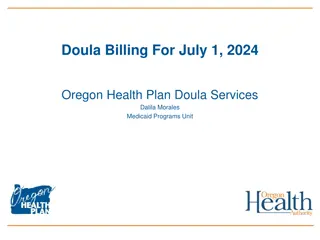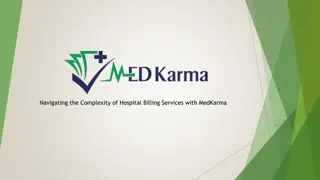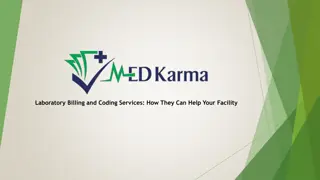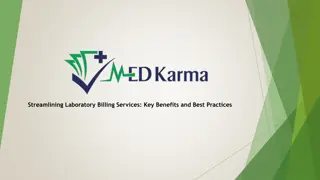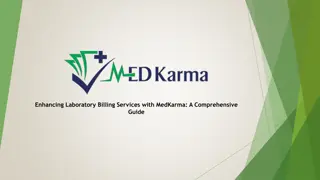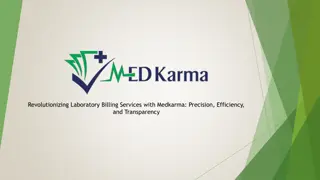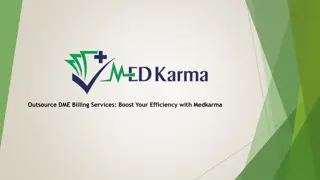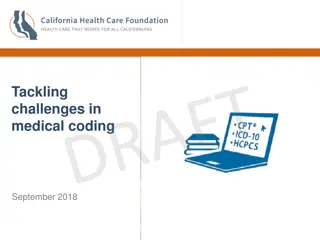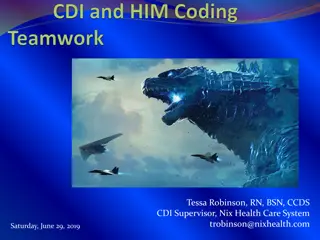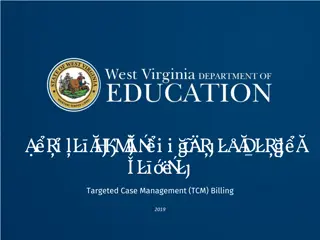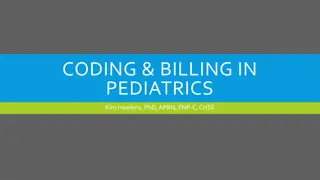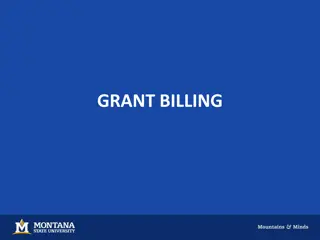Understanding Coding and Billing Opportunities in Healthcare
Explore coding and billing opportunities in healthcare, covering Evaluation and Management Services (E/M), Telehealth Services, Annual Wellness Visits (AWV), Chronic Care Management (CCM), Transitional Care Management (TCM), Risk Adjustment Coding, HCPCS Updates, and more. Learn about the criteria for medical professionals who can code and bill, including physicians, physician assistants, nurse practitioners, and clinical nurse specialists. Dive into E/M services, focusing on the level of Medical Decision Making (MDM) and criteria for time documentation.
Download Presentation

Please find below an Image/Link to download the presentation.
The content on the website is provided AS IS for your information and personal use only. It may not be sold, licensed, or shared on other websites without obtaining consent from the author. Download presentation by click this link. If you encounter any issues during the download, it is possible that the publisher has removed the file from their server.
E N D
Presentation Transcript
Coding and Billing Opportunity 2021 Shawn Bromley NEPHO Wednesday, April 28th, 2021 Disclaimer:This presentation is offered as guidance to NEPHO providers and office administration. If you are a BILH employed practice please follow up with your practice Leadership on guidance reviewed during this presentation.
Agenda Evaluation and Management Services (E/M) Telehealth Services Annual Wellness Visits (AWV) Chronic Care Management (CCM) Transitional Care Management (TCM) Risk Adjustment Coding Capture Review HCPCS Level II Quarterly Updates Ambulatory Payment Classification Updates HCPCS Updates o New Codes o Revised Codes o Deleted Codes Resources
Healthcare Professional Who Can Code and Bill Physician Physician assistant (PA) Nurse practitioner (NP) Clinical nurse specialist (CNS) Medical professional (including a health educator, registered dietician or nutrition professional, or other licensed practitioner) or a team of medical professionals working under the direct supervision of a physician.) Non-physicians must legally be authorized and qualified to provide AWVs in the state in which the services are furnished.
E/M Services The level of MDM is based on two out of three elements: Number and complexity of problems addressed o A problem is addressed when it is evaluated or treated at the encounter by the physician or other qualified professional reporting the service Amount and/or complexity of data to be reviewed and analyzed o This is the biggest change and emphasizes clinically important activities and accounts for quantity of documents ordered/reviewed. o Data is divided into three categories: Tests, documents, orders, or independent historian(s) Independent interpretation of tests Discussion of management of test interpretation with external physician/other QHP/appropriate source Risk of complications and/or morbidity or mortality of patient management o Decisions involved with the patient s problem(s) or treatment(s) including possible management options selected and considered, as well as risks associated with social determinants of health
E/M Services (continued) Criteria for Time While tracking time is not often used in the urgent care setting, it s important to understand how to use time to code a visit. With the new rules, total time is considered face-to-face and non-face- to-face on the date of the encounter by the reporting practitioner. To document, state the total time spent that day and summarize the services performed. It s important to note that the criteria for time: o Does not require the patient to be in the office o Excludes time spent by the clinical staff o Excludes time spent performing procedures o Includes time spent by NPPs when both practitioners see a patient, but can only count one person per minute
Telehealth Services Telehealth Supporting Audio/Video and Audio Only : Telehealth allows the Provider and Practice Team to engage their patients. Telehealth helps identify and meet care needs before they become acute enough to require the patient to access an in-person healthcare setting. Telehealth will help provide access to E/M, AWV, CCM, TCM, and support risk adjustment coding capture. Telehealth services are reimbursed = in person visits 99211 99202 & 99212 99203 & 99213 99204 & 99214 99205 & 99215 AWV CCM TCM
Coding and Billing AWV The two CPT codes used to report AWV services are: G0438 initial visit G0439 subsequent visit G0438: Billable for the first AWV only. Patient is eligible after the first 12 months of Medicare coverage. For services within the first 12 months, conduct the Initial Preventive Physical Exam (IPPE), also referred to as the Welcome to Medicare Visit (G0402). G0439: Billable for subsequent AWV. The patient cannot have had a prior AWV in the past 12 months.
Components of the G0438 Initial AWV The patient must not have received an IPPE (G0402) within the past 12 months. Administer a Health Risk Assessment (HRA) that includes, at a minimum: demographic data, self-assessment of health status, psychosocial and behavioral risks, and activities of daily living (ADLs), instrumental ADLs including but not limited to shopping, housekeeping, managing own medications, and handling finances. Establish the patient s medical and family history. Establish a list of current physicians and providers that are regularly involved in the medical care of the patient. Obtain blood pressure, height, weight, body mass index or waist circumference, and other measurements, as deemed appropriate. Assess patient s cognitive function. Review risk factors for depression, including current or past experiences with depression or mood disorders. Review patient s functional ability and safety based on direct observation, or the use of appropriate screening questions. Establish a written screening schedule for the individual, such as a checklist for the next 5 to 10 years based on appropriate recommendations. Establish a list of risk factors and conditions for primary, secondary, or tertiary intervention. Provide personalized health advice to the patient, as appropriate, including referrals to health education or preventive counseling services and programs.
Components of the G0439 Subsequent AWV The patient cannot have had a prior AWV in the past 12 months. Update the HRA. Update the patient s medical and family history. Update the current physicians and providers that are regularly involved in providing the medical care to the patient, as developed during the initial AWV. Obtain blood pressure, weight (or waist circumference, if appropriate), and other measurements, as deemed appropriate. Assess patient s cognitive function. Update the written screening schedule checklist established in the initial AWV. Update the list of risk factors and conditions for which primary, secondary, and tertiary interventions are recommended or underway. Provide personalized health advice to the patient, as appropriate, including referrals to health education or preventive counseling services and programs. At the patient's discretion, the subsequent AWV may also include advance care planning services.
E/M Billing During AWV In addition, if an insignificant issue or abnormality is discovered while performing the AWV and it does not require additional work, an E&M code should not be reported with the AWV code. If both codes are reported, make sure that the documentation supports both services and that there are no overlapping components. The following are some helpful tips regarding claim submission when reporting an AWV: List all chronic conditions. When using an E&M code (CPT codes 99201-99215) for a sick visit with the AWV, use the diagnosis code(s) that represents the problem or abnormality to match the additional documentation in the medical record. Remember to add modifier -25 to the E&M code. Example: The patient comes in for AWV and it is discussed that they are experiencing severe abdominal pain after they workout. This has been happening for the last few months. The provider would code the subsequent AWV G0439 and will bill a 99213-25. The provider is also going to refer the patient to a Gastroenterologist.
Chronic Care Management (CCM) The five CPT codes used to report CCM services are: CPT code 99490 - non-complex CCM is a 20-minute timed service provided by clinical staff to coordinate care across providers and support patient accountability. CPT code 99439 - each additional 20 minutes of clinical staff time spent providing non-complex CCM directed by a physician or other qualified health care professional (billed in conjunction with CPT code99490) CPT code - 99487 complex CCM is a 60-minute timed service provided by clinical staff to substantially revise or establish comprehensive care plan that involves moderate- to high-complexity medical decision making. CPT code 99489 is each additional 30 minutes of clinical staff time spent providing complex CCM directed by a physician or other qualified health care professional (report in conjunction with CPT code 99487; cannot be billed with CPT code 99490) CPT code 99491 - CCM services provided personally by a physician or other qualified health care professional for at least 30 minutes.
CCM Guidelines Documentation: Management of chronic conditions Management of referrals to other providers Management of prescriptions Ongoing review of patient status Non-complex CCM (CPT code 99490) Requirements: Two or more chronic conditions expected to last at least 12 months (or until the death of the patient) Patient consent (verbal or signed) Personalized care plan in a certified EHR and a copy provided to patient 24/7 patient access to a member of the care team for urgent needs Enhanced non-face-to-face communication between patient and care team Management of care transitions At least 20 minutes of clinical staff time per calendar month spent on non-face-to-face CCM services directed by physician or other qualified health care professional CCM services provided by a physician or other qualified health care professional are reported using CPT code 99491 and require at least 30 minutes of personal time spent in care management activities
Transitional Care Management (TCM) CPT code 99495 moderate medical complexity requiring a face-to-face visit within 14 days of discharge CPT code 99496 high medical complexity requiring a face-to-face visit within seven days of discharge Requirements and Components for TCM o Contact the beneficiary or caregiver within two business days following a discharge. The contact may be via telephone, email, or a face-to-face visit. Attempts to communicate should continue after the first two attempts in the required business days until successful. o Conduct a follow-up visit within 7 or 14 days of discharge, depending on the complexity of medical decision making involved. The face-to-face visit is part of the TCM service and should not be reported separately. o Medicine reconciliation and management must be furnished no later than the date of the face-to-face visit. o Obtain and review discharge information. o Review the need for diagnostic tests/treatments and/or follow up on pending diagnostic tests/treatments. o Educate the beneficiary, family member, caregiver, and/or guardian. o Establish or re-establish referrals with community providers and services, if necessary. o Assist in scheduling follow-up visits with providers and services, if necessary. Discharge from any of the following: o Inpatient acute care hospital o Long-term acute care hospital o Skilled nursing facility/nursing facility o Inpatient rehabilitation facility o Hospital observation status or partial hospitalization
Risk Adjustment Coding Capture Recapture chronic conditions every year Conditions we know the patient has Problem list, conditions treated last year and still monitored and/or treated Conditions others have documented Hospital, Consults, and Radiology High prevalence conditions Conditions in remission Major Depression, Single, Full Remission F32.5 o Patient has had two or more depressive episodes in the past but has been free from depressive symptoms for several months. This category can still be used if the patient is receiving treatment to reduce the risk of further episodes. Alcohol Dependence, in Remission F10.21 o After an alcoholic has successfully stopped drinking for a period of time or has changed the pattern of use to one that does not meet the criteria of dependence, a diagnosis of alcohol dependence may still apply but the condition will be classified as in remission. Identify new diagnosis New conditions that develop
Ambulatory Payment Assignments (APC) Updates Revised Ambulatory Payment Classification Assignments (APC) for Pfizer-BioNTech and Moderna COVID-19 CPT Administration Codes The APC assignments for the administration codes are being reassigned. CPT codes 0001A (Pfizer Administration/Immunization code first dose) and 0011A (Moderna Administration/Immunization code first dose) from APC 1492 to APC 9397, and CPT codes 0002A (Pfizer Administration/Immunization code second dose) and 0012A (Moderna Administration/Immunization code second dose) from APC 1493 to APC 9398. Janssen/Johnson & Johnson COVID-19 Vaccine and Vaccine Administration Code The American Medical Association (AMA) released 2 new CPT codes associated with this vaccine: CPT code 91303 vaccine product code CPT cod 0031A Administration/Immunization code Following is a list of new HCPCS codes for therapies that have been granted a Emergency Use Authorization by the FDA and the effective date for the codes: M0245 and Q0245 established effective February 9, 2021 for bamlanivimab and etesevimab administered together.
HCPCS Coding Updates New Codes: A9592 Copper cu-64, dotatate, diagnostic, 1 millicurie C9074 Injection, lumasiran, 0.5 mg C9777 Esophageal mucosal integrity testing by electrical impedance, transoral (list separately in addition to code for primary procedure) G2020 Services for high intensity clinical services associated with the initial engagement and outreach of beneficiaries assigned to the sip component of the pcf model (do not bill with chronic care management codes). CMS recommends that the G2020 service must be provided and billed at least one day before any other services subject to the flat visit fee may be reimbursed accordingly. G2172 All inclusive payment for services related to highly coordinated and integrated opioid use disorder (oud) treatment services furnished for the demonstration project J1427 Injection, viltolarsen, 10 mg J1554 Injection, immune globulin (asceniv), 500 mg J7402 Mometasone furoate sinus implant, (sinuva), 10 micrograms J9037 Injection, belantamab mafodontin-blmf, 0.5 mg
HCPCS Coding Updates (continued) J9349 Injection, tafasitamab-cxix, 2 mg K1013 Enema tube, any type, replacement only, each K1014 Addition, endoskeletal knee-shin system, 4 bar linkage or multiaxial, fluid swing and stance phase control K1015 Foot, adductus positioning device, adjustable K1016 Transcutaneous electrical nerve stimulator for electrical stimulation of the trigeminal nerve K1017 Monthly supplies for use of device coded at k1016 K1018 External upper limb tremor stimulator of the peripheral nerves of the wrist K1019 Monthly supplies for use of device coded at k1018 K1020 Non-invasive vagus nerve stimulator M0245 Intravenous infusion, bamlanivimab and etesevimab, includes infusion and post administration monitoring Q0245 Injection, bamlanivimab and etesevimab, 2100 mg Q2053 Brexucabtagene autoleucel, up to 200 million autologous anti-cd19 car positive viable t cells, including leukapheresis and dose preparation procedures, per therapeutic dose S1091 Stent, non-coronary, temporary, with delivery system (propel)
HCPCS Coding Updates (continued) Revised Codes: C9761 Cystourethroscopy, with ureteroscopy and/or pyeloscopy, with litotripsy, and ureteral catheterization for steerable vacuum aspiration of the kidney, collecting system, ureter, bladder, and urethra if applicable G9868 Receipt and analysis of remote, asynchronous images for dermatologic and/or ophthalmologic evaluation, for use only in a Medicare-approved cmmi model, less than 10 minutes G9869 Receipt and analysis of remote, asynchronous images for dermatologic and/or ophthalmologic evaluation, for use only in a Medicare-approved cmmi model, 10-20 minutes G9870 Receipt and analysis of remote, asynchronous images for dermatologic and/or ophthalmologic evaluation, for use only in a Medicare-approved cmmi model, more than 20 minutes J7321 Hyaluronan or derivative, hyalgan, supartz or visco-3, for intra-articular injection, per dose Deleted HCPCS Level II Codes C9068 Copper cu-64, dotatate, diagnostic, 1 millicurie C9069 Injection, belantamab mafodontin-blmf, 0.5 mg C9070 Injection, tafasitamab-cxix, 2 mg C9071 Injection, viltolarsen, 10 mg
HCPCS Coding Updates (continued) C9072 Injection, immune globulin (asceniv), 500 mg C9073 Brexucabtagene autoleucel, up to 200 million autologous anti-cd19 car positive viable t cells, including leukapheresis and dose preparation procedures, per therapeutic dose C9122 Mometasone furoate sinus implant, 10 micrograms (sinuva) J7333 Hyaluronan or derivative, visco-3, for intra-articular injection, per dose J7401 Mometasone furoate sinus implant, 10 micrograms K1010 Indwelling intraurethral drainage device with valve, patient inserted, replacement only, each K1011 Activation device for intraurethral drainage device with valve, replacement only, each K1012 Charger and base station for intraurethral activation device, replacement only
Resources Shawn Bromley, NEPHO Director Contracting and Operations Lead Coding Initiatives shawn.m.bromley@lahey.org or 978-236-1704 https://www.aafp.org/family-physician/practice-and-career/getting- paid/coding/transitional-care-management.html https://www.aafp.org/family-physician/practice-and-career/getting- paid/coding/chronic-care-management.html https://emuniversity.com/ https://www.cnchealthplan.com/wp-content/uploads/2017_08_CNC_RAF-101.pdf

 undefined
undefined

